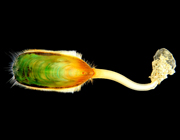
The genome project of the lingulid brachiopod Lingula anatina.
The 425-Mb genome (3,830 scaffolds with contig N50 in 56 kbp and scaffold N50 in 294 kbp) was sequenced from male gonads with four different NGS platforms, including 454 (GS FLX+), Illumina (MiSeq and HiSeq 2500), and PacBio (RS II). In total, 96-Gb data were sequenced with ~226-fold coverage. The genome was assembled with Newbler (v2.9), SSPACE (v3.0), SSPACE-LongRead (v1-1), and GapCloser (v1.12-r6).
Deep RNA-seq data are also provided. The transcriptome assembly was assembled de novo with Trinity (r2013_08_14) as the result from a pool of ten embryonic stages (fertilized egg, 32-cell to 128-cell, 128-cell to early blastula, early blastula, blastula, early gastrula, mid gastrula, late gastrula, 1-pair-cirri larva, and 2-pair-cirri larva) and seven adult tissues (lophophore, whole gut tissue, digestive cecum, dorsal mantle, ventral mantle, pedicle, and regenerated pedicle). Totally, 369 M read pairs were sequenced with read length in 100 bp (~729-fold coverage). There are 47,943 non-redundant transcripts after CD-HIT clustering.
This genome project has been registered in NCBI under the BioProject accession PRJNA286275. The genome assembly has been deposited at DDBJ/EMBL/GenBank under the accession LFEI00000000.
Sequencing reads of the genome and transcriptome have been deposited in NCBI Sequence Read Archive under the study accession SRP059398.
In additional to our annotation, the Lingula genome has also been annotated by the NCBI Eukaryotic Genome Annotation Pipeline. Please check NCBI Lingula anatina Annotation Release 100 for details.
The Lingula genome overview in NCBI is here. The NCBI Lingula BLAST page is also available.
NOTE: You can search gene ID on the left column by adding a letter "g" and removing "all zeros" in front of the ID number as the following.
For example: 09932_LINAN (UniProt format) <--> g9932 (genome browser format)
And then you will find a BMP4 orthologous gene in Lingula. The transcript ID is in Trinity format such like comp125124_c3_seq14 (one isoform for g9932).
»For checking the expression profile, please find the tutorial for details.
The Lingula genome provides insights into brachiopod evolution and the origin of phosphate biomineralization.
Nature Communications, 6, 8301. (2015) DOI:10.1038/ncomms9301
